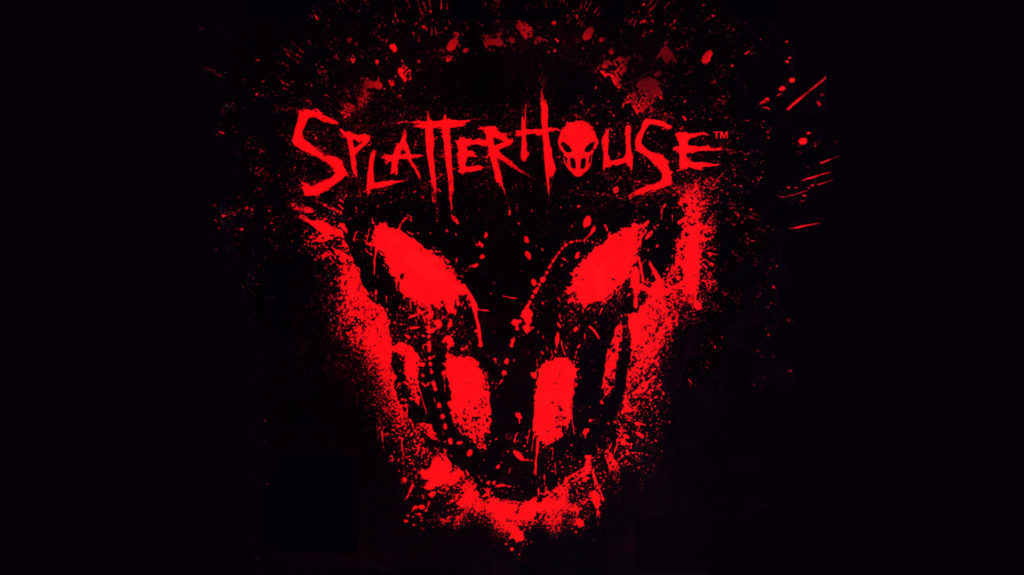
This November will mark the 10th anniversary of Rely on Horror. Although I’ve only been a contributor to the site for a little over a year now, I’ve been a fan and follower for a lot longer. Since I’ve joined, I’ve been able to work with our talented staff on a number of exciting projects. We’re a small, close-knit team united by our love of all things horror. I’m proud to be a part of this site and proud that we’re able to continue to provide readers with exclusive news, reviews and in-depth articles. For everything horror-related, we’re still the site you can rely on. Here’s to 10 more fantastically horrifying years!
When Splatterhouse (2010) was first released on November 23, 2010, for the PS3 and Xbox 360, the overall critical consensus was that it was, to put it mildly, lacking. Reviews were mixed, with many who sung its praise, but there were just as many detractors who complained that it was a monotonous button-masher with shallow gameplay, an inconsistent framerate and laggy controls, not to mention that its content was cheap, pandering and exploitative. The game’s current Metacritic averages are 59% for the PS3 and 62% for the 360, respectively.
With all due respect to the critical consensus, I heartily disagree.
I love this game. Maybe I’ve built up a high tolerance for games that are a little rough around the edges by playing tons of early PS1 and PC horror games, but none of the things critics at the time complained about actually bothered me. Is it perfect? No. It has flaws, both technical and graphical, and I’d be lying if I said some of the things about it weren’t annoying, like the long load times and some of the cheap deaths, but they didn’t significantly detract from the experience as a whole for me. I know the internet is famous for defending anything, no matter how bad it actually is, but in this case, I really think the majority of hate this game gets is largely misplaced.
In celebration of Splatterhouse’s upcoming 9th anniversary, I’d like to take a look back and talk about what makes it so great and why I think it deserves another look by some who may have written it off as a mostly broken game not worth their time. It’s October, Halloween’s right around the corner and there’s no better time to take a trip back inside West Mansion, better known to some as the Splatterhouse…
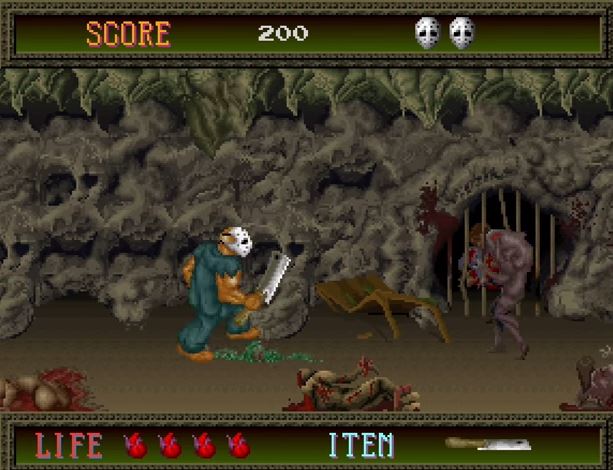 Greatness from small beheadings, Splatterhouse 1988
Greatness from small beheadings, Splatterhouse 1988
I remember hearing about the original Splatterhouse games as a kid. They were always those taboo games I never played, but always saw ads for in gaming magazines. I specifically remember the covers grabbing my attention. They were spooky and evocative, and had a very different look and feel from anything else out at the time. The first game in the series was released for the arcade in 1988, with a home port on the TurboGrafx-16, and two later sequels for the Sega Genesis. It’s no coincidence that the main character Rick bears a striking resemblance to a certain hockey-masked killer; the games took inspiration from movies like Friday the 13th and Evil Dead, among others. Some felt he looked a little too similar, however, and the color of Rick’s mask was later modified from white to red for the home release, to avoid any further similarity to Jason Voorhees.
On the surface, some of the elements the Splatterhouse games borrow might seem derivative, but they meld them together in a way that feels fresh and accessible. The games immerse you in the experience. You’re no longer passively watching a horror movie, you’re playing one. There was nothing else like them. They were fun and gory (not to mention notoriously hard) and were precursors to the M-rated gaming world we all know today. Early on, the series got in trouble for its content, with many critics at the time labeling the games as gratuitous and exploitative. It wouldn’t be until many years later that I would finally get the chance to play them for myself.
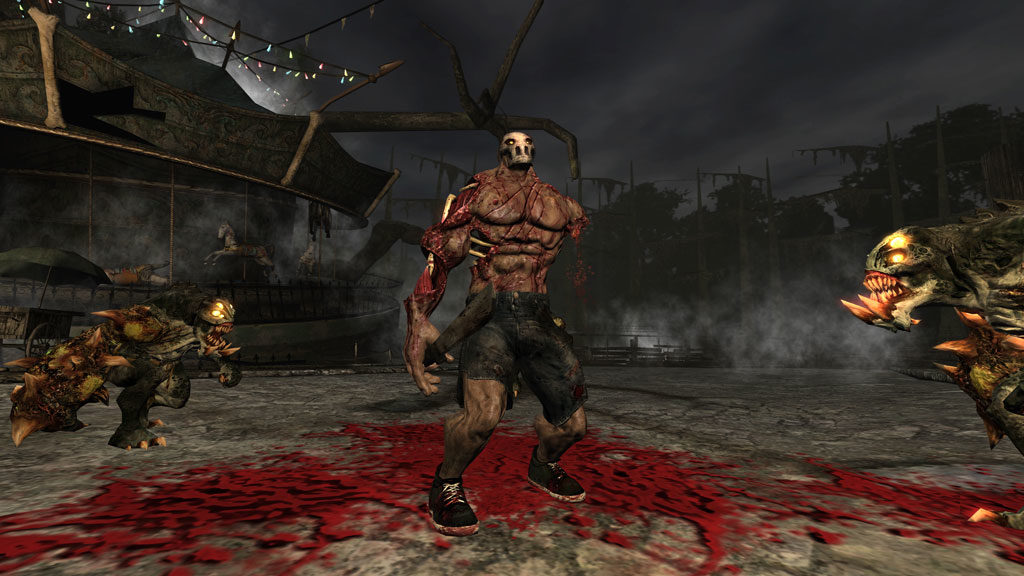 Not quite there yet, Early BottleRocket build
Not quite there yet, Early BottleRocket build
In 2008, when Namco Bandai announced that they were working on a new installment of the series, my ears perked up. Splatterhouse reimagined as a modern 3D brawler on then current-gen consoles? Hell, yeah! Fans, however, would have to wait a while before the finished product was finally released. The game had a troubled development cycle, to say the least, and was almost canceled multiple times for not delivering on the vision the publisher wanted. This rocky development period included many costly and time-consuming setbacks, including initial developer BottleRocket being shuttered, while another team working internally at Bandai Namco (composed partially of ex-BottleRocket employees) reworked and completed the final version of the game. This made it near impossible to polish the game in the way the developers intended and as a result, they felt that the game that shipped contained only about 75% of what they wanted to include.
At the time I was unaware of any of the behind the scenes conflicts, I was just looking forward to the game’s release. I reserved myself a copy, nabbing a sweet miniature Terror Mask pre-order bonus in the process (which still sits proudly atop my living room bookshelf to this day). Although the game had some wonky early previews that showed a rough version of Rick’s character model and some work in progress enemies and environments, as far as I was concerned the game that I played upon release turned out incredible and well worth the wait. I was so enamored with it that I played it twice, back to back. I ended up falling in love with it and play it every October, in celebration of the game’s awesome atmosphere, blood-drenched gameplay and cool Halloween vibe.
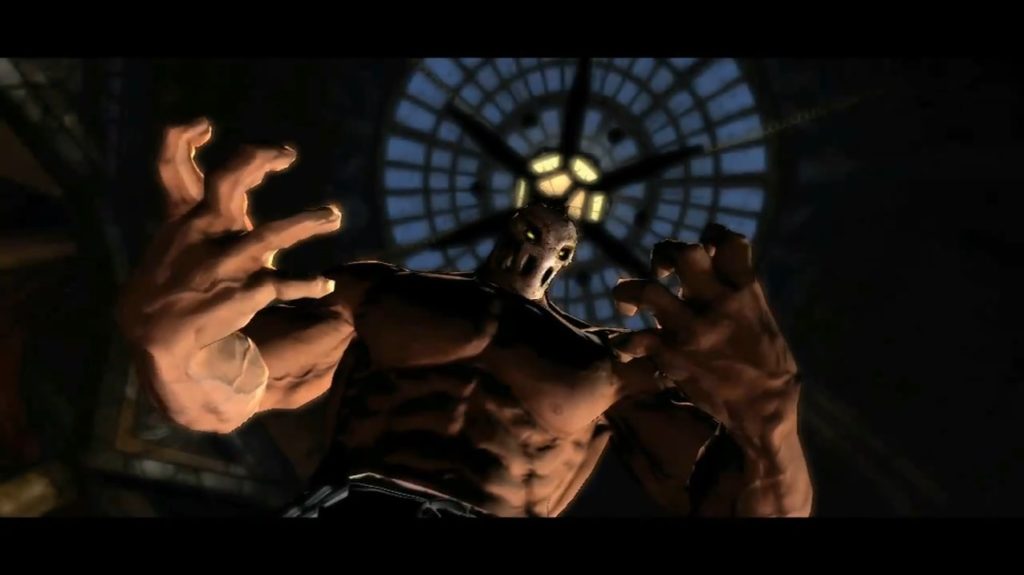 She doesn’t have to die…
She doesn’t have to die…
The basic plot of Splatterhouse (2010) is basically a revamped version of the original game’s story but expanded considerably. As before, protagonist Rick’s girlfriend Jennifer has been kidnapped by the evil Dr. West and Rick must survive the horrors of West’s mansion to save her. This time around Jennifer is a student on her way to interview the well renowned, but controversial Dr. West. Her nerdy, but lovable boyfriend Rick tags along to make sure everything’s on the up and up. As it turns out, it not, in a bad way. West promptly abducts Jennifer, Rick suffers a fatal wound, and as he lies dying in a pool of his own blood, he hears a voice call out to him. Just as he’s about to slip away, Rick comes into contact with the Terror Mask, a mysterious skull-shaped artifact with a mind of its own (voiced by prolific voice actor Jim Cummings of Darkwing Duck and Winnie the Pooh fame). It makes a deal with Rick – he’ll help him save Jennifer if Rick helps him with what he wants. Rick accepts the offer and the mask grafts itself onto his face, violently transforming him into a hulking, 7-foot-tall brute. It’s now up to Rick to save Jennifer from being sacrificed and put an end to West’s diabolical plan to summon a group of dark deities known as The Corrupted.
The story is broken up into chapters, all leading towards an impending prophecy of world-ending doom. It’s well fleshed-out and honestly way better than it has to be for this type of game. I’m not complaining at all, but man does this story go above and beyond, with numerous references and callbacks to previous entries in the series. It’s compelling and drives the game forward in new and interesting ways.
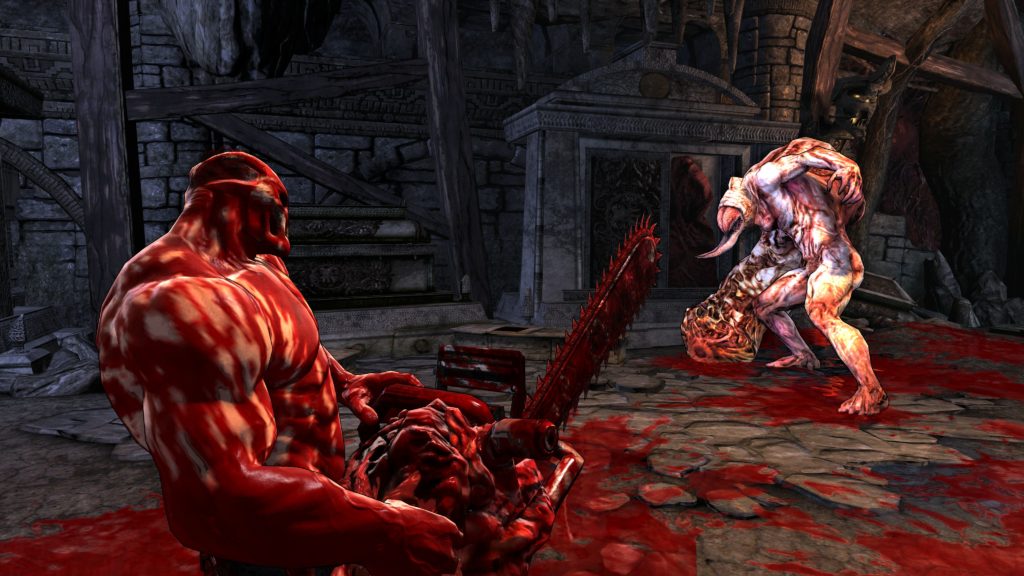 Completely covered in blood
Completely covered in blood
The gameplay is a blend of hack and slash combat and exploration, broken up by a couple of 2D side-scrolling sections that pay homage to the retro look and feel of the classic games. In addition to the standard moveset of punches, kicks and running slams, Rick also has a number of melee weapons at his disposal including a 2×4, machete, chainsaw and even his own severed arm. You can even use the severed limbs and heads of enemies as weapons. You feel powerful as Rick and combat is brutal and satisfying. Enemies splat, blood and goo fly everywhere and you feel the weight of every blow. It’s so much fun!
Splatterhouse (2010) is one of the bloodiest games ever made. Every punch you throw, every head you split open, every enemy you dispatch is accompanied by a gushing fountain of viscous crimson fluid. It’s gory and gruesome and it gets everywhere. This game is unapologetically gore-soaked and revels in it. How many games let you get completely covered in blood? Blood also plays a big part in the game’s combat system. Along with the regular health meter, there’s also a separate bar called the Necro Meter. As Rick kills enemies, he absorbs blood which can then be used to power different abilities, including the ability to refill your health meter and even initiate Berserker Mode, which transforms Rick into a super Hulked-out version of himself who can perform extremely powered up kills. The duration of these abilities is limited and once the Necro Meter has been depleted, players have to build it back up by slaying more enemies.
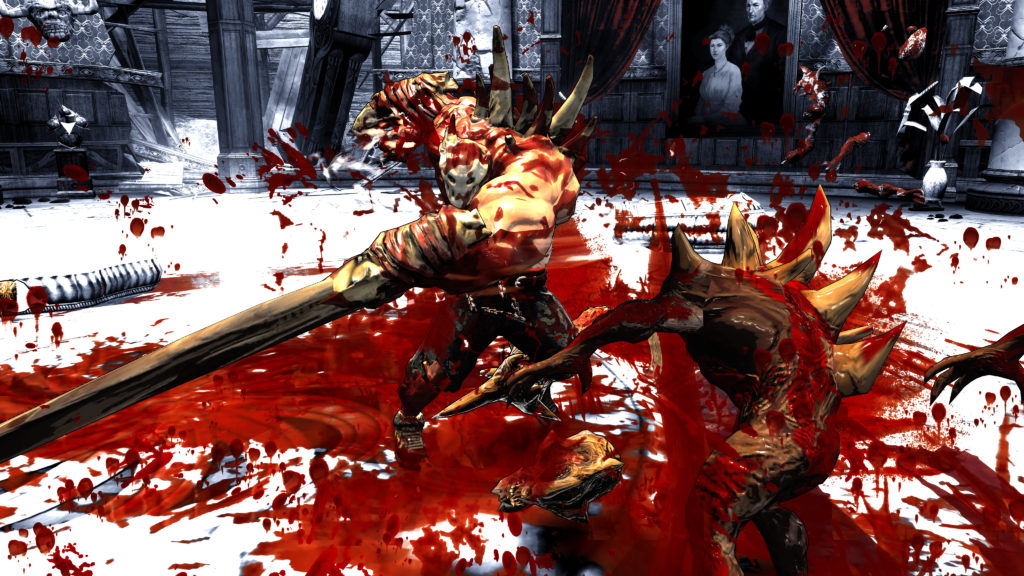 Indulge your bloodlust in Berserker Mode
Indulge your bloodlust in Berserker Mode
Another combat mechanic in the game is the Splatter Kill. Once an enemy has been sufficiently weakened, a red outline will appear around them and Rick can choose to initiate a quick time-based “Splatter Kill”, which if done successfully grants him the ability to execute an especially brutal finishing move on his enemies. Some of these are especially gruesome and at least one of them had me grimace at its very…intimate brutality. Some people had a hard time with the 2D side-scrolling sections, and I’ll admit there were a lot of cheap deaths in them, but overall I enjoyed the retro vibe they had, especially the 16-bit throwback music that played during these sections. There were a nice way to break up the normal 3D traversal sections of the game.
Simply put, this is 3D Splatterhouse. It’s faithful to the gameplay and genre aesthetic of the original series and expands the characters and plot in meaningful ways. As a bonus, it also includes all three of the original games as unlockables, including the rare arcade version of the first Splatterhouse. To many, this is worth the price of admission alone. These three games are horror classics and it’s such a treat to be able to play them all in one place.
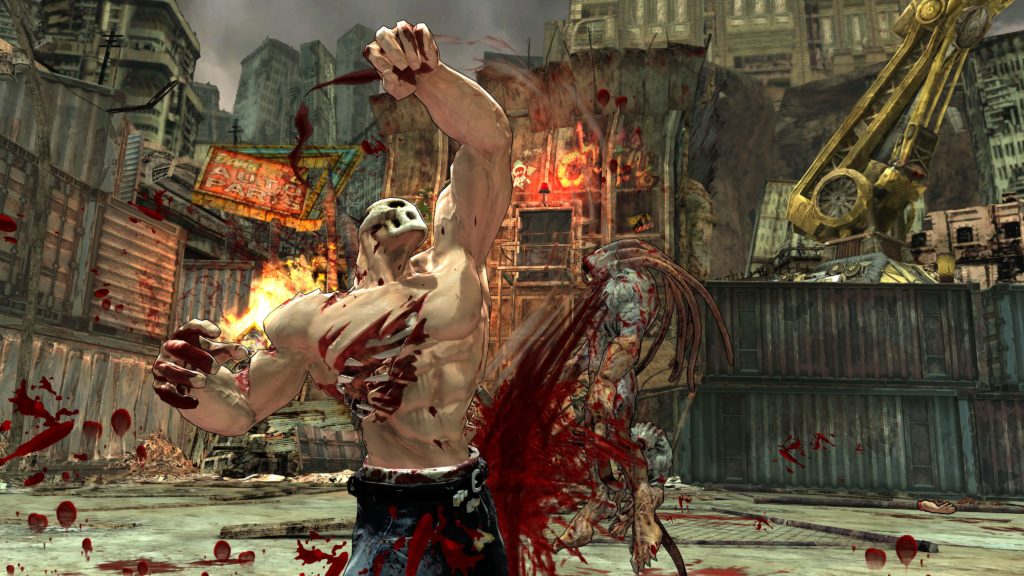 No guts, no glory
No guts, no glory
In addition to playing great, the game also looks fantastic. Rick’s character model is easily one of the highlights of the game, not to mention the gory, incremental damage his body sustains throughout the game, which exposes guts, bone and muscle. The developers even showed off a 3D-printed version of the model for a promotional display at E3 2010. Character and enemy designs are diverse and suitably grotesque, ranging from smaller packs of ravenous grey demons to four-story tall boss monsters. The art style has a semi cell-shaded look, with characters displaying a black outline around them. It all contributes to forming a robust look that connects the player to the game’s world. The game also features some insane concept and promotional art by Dave Wilkins, which ended up becoming the first videogame on the cover of Fangoria magazine.
Environments are varied and include such locations as the spooky interiors of West mansion, a haunted amusement park, a booby trap-filled dungeon, a grimy meat factory and an apocalyptic cityscape, to name a few. They’re all rendered gorgeously with little bits of detail and background action that really make them feel alive. This game goes to some weird, surreal places and the environments serve to punctuate Rick’s journey as he navigates through the dark dimensions and times on his quest. The game isn’t outright scary, but it’s got what I like to call a “spooky-cool vibe,” as in, things are creepy and atmospheric, but aren’t actually frightening.
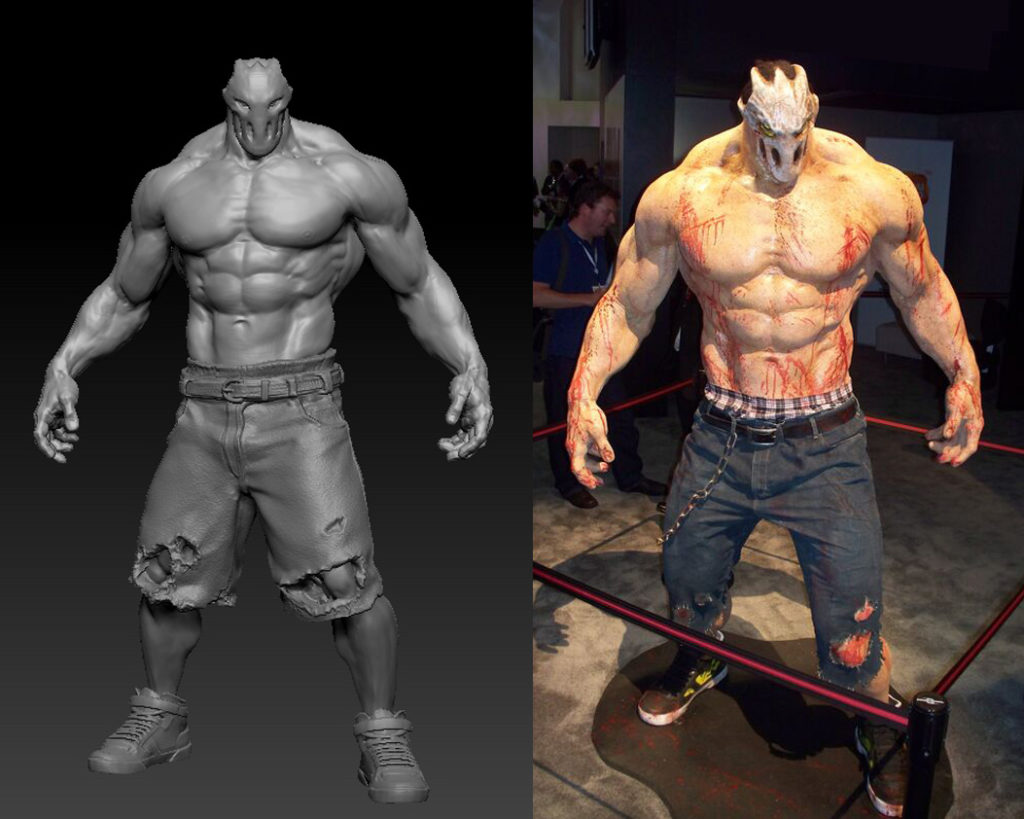 Rick, E3 2010
Rick, E3 2010
No look back at this game would be complete without mentioning the music. The game’s score is composed by Howard Drosin and consists primarily of atmospheric tracks mixed with rock and death metal songs from bands like Lamb of God, Five Finger Death Punch, Mastodon and Goatwhore. I personally love the soundtrack, and while I’m not a big Death Metal guy and am usually opposed to including rock in horror movies and games as a general rule, I think in this case it perfectly fits the tone and atmosphere of this game. The music is thumping and really gets you in the mood to bust some heads. There’s nothing like smashing up a bunch of bloodthirsty fishmen to a blasting beat to get your blood pumping.
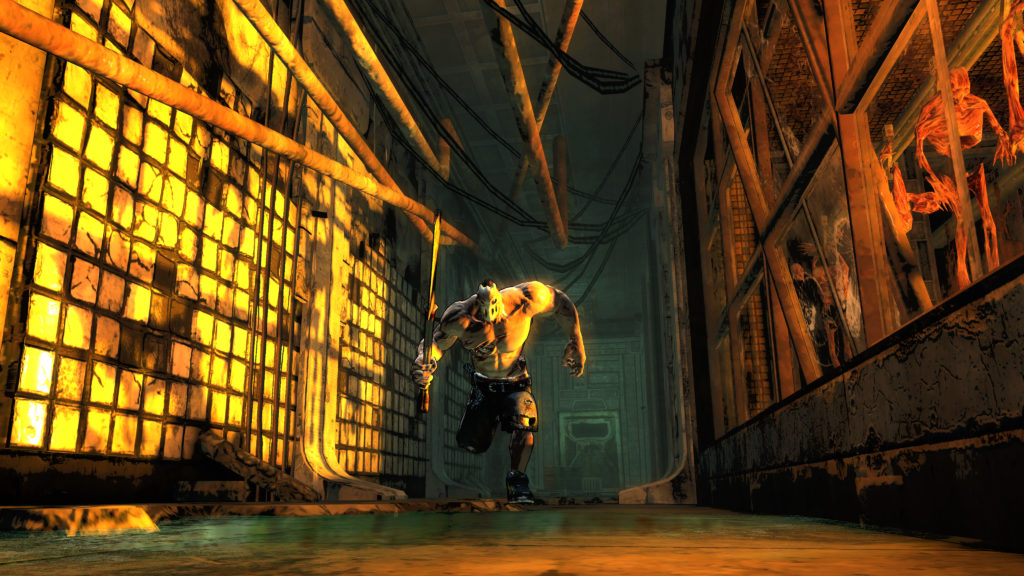 Try to enjoy the daylight
Try to enjoy the daylight
FINAL THOUGHTS
For years, many had written Splatterhouse (2010) off as a cheap, buggy, shallow brawler and unfairly labeled it a bad game. While I’ll admit that it lacks some variety and can be superficially challenging at times, I still think it holds up today as a solid, satisfying hack and slash title with style and substance to spare. The gameplay is brutally satisfying and its story is compelling and will keep you involved throughout the whole playthrough. Anyone who has a passing interest in gory, action-filled beat ’em ups should definitely give this game a try. Prices on Amazon and eBay are pretty reasonable right now and if you have a working PS3 or 360, I highly recommend picking up a copy.
There’s no better time than Halloween to start smashing heads and spilling blood, and no game does that better than the one and only Splatterhouse!




